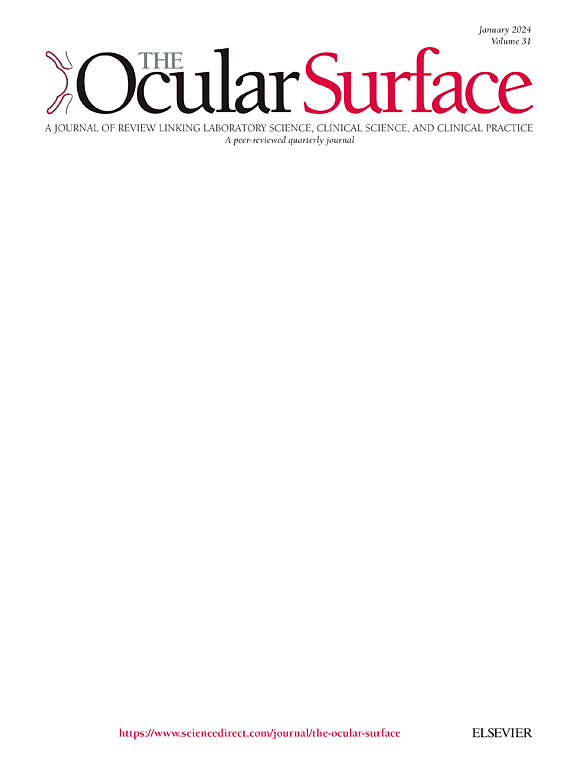Cytarabine chemotherapy induces meibomian gland dysfunction
IF 5.9
1区 医学
Q1 OPHTHALMOLOGY
引用次数: 0
Abstract
Purpose
Cytarabine (Ara-C) chemotherapy causes symptoms resembling meibomian gland dysfunction (MGD), suggesting potential associations between Ara-C and MGD. In this study, the pathological effects of Ara-C on MGD were investigated in a rodent model.
Methods
Mice received Ara-C with or without rosiglitazone (PPARγ agonist) for 7 consecutive days. Slit-lamp biomicroscope was used for ocular examinations. Immunofluorescence detected acinar cell proliferation, differentiation, and ductal keratinization in the meibomian gland (MG). Lipid accumulation was evaluated by Oil Red O and LipidTox staining. Lipogenic status, FoxO1/FoxO3a cellular localization, and oxidative stress were visualized via immunohistochemistry. Western blotting assessed relative protein expression and AKT/FoxO1/FoxO3a pathway phosphorylation.
Results
Ara-C (50 mg/kg) did not affect mouse survival but induced damage to ocular surface microenvironment, including corneal epithelial defects, MG orifice plugging and acinar dropout, and lacrimal gland (LG) dysfunction. Ara-C intervention inhibited proliferation and caused progenitor loss in the MG, as evidenced by reduced PCNA + labeling and P63+/Lrig1+ basal cell numbers. The MG ducts of Ara-C-treated mice exhibited marked dilatation, lipid deposition, and hyperkeratinization (K1/K10 overexpression). Ara-C disrupted MG lipid metabolism by downregulating PPARγ and its downstream lipogenic targets AWAT2/SOAT1/ELOVL4 and upregulating HMGCR. Dephosphorylation of AKT and the subsequent nuclear translocation of FoxO1/FoxO3a contributed to Ara-C-induced PPARγ downregulation. Ara-C triggered oxidative stress with increases in 4-HNE and 8-OHdG and Keap1/Nrf2/HO-1/SOD1 axis dysregulation. Rosiglitazone treatment ameliorated MGD-associated pathological manifestations, LG function, MG lipid metabolism, and oxidative stress in Ara-C-exposed mice.
Conclusions
Systemic Ara-C chemotherapy exerted topical cytotoxic effects on the ocular surface, and PPARγ restoration by rosiglitazone mitigated Ara-C-induced MGD alterations.
阿糖胞苷化疗诱发睑板腺功能障碍
目的阿糖胞苷(Ara-C)化疗会导致类似睑板腺功能障碍(MGD)的症状,这表明 Ara-C 和 MGD 之间可能存在关联。本研究在啮齿动物模型中研究了 Ara-C 对 MGD 的病理影响。使用裂隙灯生物显微镜进行眼部检查。免疫荧光检测睑板腺(MG)中的尖状细胞增殖、分化和导管角化。油红 O 和脂毒染色法评估了脂质积累情况。通过免疫组化观察生脂状态、FoxO1/FoxO3a细胞定位和氧化应激。结果 Ara-C(50 毫克/千克)不影响小鼠的存活率,但会导致眼表微环境受损,包括角膜上皮缺损、MG 口堵塞和尖锐湿疣脱落以及泪腺(LG)功能障碍。Ara-C干预抑制了MG的增殖并导致祖细胞丢失,PCNA+标记和P63+/Lrig1+基底细胞数量的减少证明了这一点。经 Ara-C 处理的小鼠的 MG 管表现出明显的扩张、脂质沉积和过度角质化(K1/K10 过度表达)。Ara-C 通过下调 PPARγ 及其下游致脂靶标 AWAT2/SOAT1/ELOVL4 和上调 HMGCR 破坏了 MG 的脂质代谢。AKT 的去磷酸化和随后 FoxO1/FoxO3a 的核转位有助于 Ara-C 诱导的 PPARγ 下调。Ara-C 引发氧化应激,导致 4-HNE 和 8-OHdG 增加,Keap1/Nrf2/HO-1/SOD1 轴失调。结论 系统性 Ara-C 化疗对眼表产生局部细胞毒性作用,罗格列酮对 PPARγ 的恢复减轻了 Ara-C 诱导的 MGD 改变。
本文章由计算机程序翻译,如有差异,请以英文原文为准。
求助全文
约1分钟内获得全文
求助全文
来源期刊

Ocular Surface
医学-眼科学
CiteScore
11.60
自引率
14.10%
发文量
97
审稿时长
39 days
期刊介绍:
The Ocular Surface, a quarterly, a peer-reviewed journal, is an authoritative resource that integrates and interprets major findings in diverse fields related to the ocular surface, including ophthalmology, optometry, genetics, molecular biology, pharmacology, immunology, infectious disease, and epidemiology. Its critical review articles cover the most current knowledge on medical and surgical management of ocular surface pathology, new understandings of ocular surface physiology, the meaning of recent discoveries on how the ocular surface responds to injury and disease, and updates on drug and device development. The journal also publishes select original research reports and articles describing cutting-edge techniques and technology in the field.
Benefits to authors
We also provide many author benefits, such as free PDFs, a liberal copyright policy, special discounts on Elsevier publications and much more. Please click here for more information on our author services.
Please see our Guide for Authors for information on article submission. If you require any further information or help, please visit our Support Center
 求助内容:
求助内容: 应助结果提醒方式:
应助结果提醒方式:


